
 |
Tea Clipper |
 |
| from TeaAntiques.com | ||
| Edition Fifty |
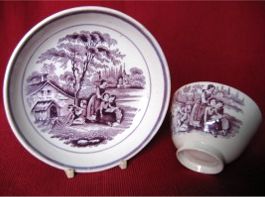 A charming little tea bowl and saucer beautifully
decorated with a rural scene depicting a mother with a young daughter and son
with a book, along with another young girl with a dog sat outside its
kennel. This scene is applied to the front and back of tea bowl and to the
inside of the saucer. A smaller print of a woman crossing a footpath is applied
to the inside of the tea bowl. This type of tea bowl and saucer decorated in
this lustre purple tone was popular in England c1820, from when this tea bowl
and saucer date.
A charming little tea bowl and saucer beautifully
decorated with a rural scene depicting a mother with a young daughter and son
with a book, along with another young girl with a dog sat outside its
kennel. This scene is applied to the front and back of tea bowl and to the
inside of the saucer. A smaller print of a woman crossing a footpath is applied
to the inside of the tea bowl. This type of tea bowl and saucer decorated in
this lustre purple tone was popular in England c1820, from when this tea bowl
and saucer date.
More details of this item and other tea related antiques can be found by visiting my web site at www.TeaAntiques.com.
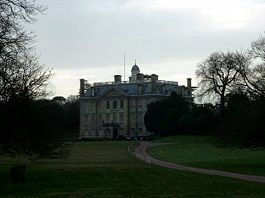 A
beautiful house in Dorset, Kingston Lacy was the ancestral home of the Banks
family for over 300 years, but now in the hands of the National Trust. The house
built by Sir Ralph Banks originates from the 17th century, but had major
alterations in the nineteenth century by architect Sir Charles Barry.
A
beautiful house in Dorset, Kingston Lacy was the ancestral home of the Banks
family for over 300 years, but now in the hands of the National Trust. The house
built by Sir Ralph Banks originates from the 17th century, but had major
alterations in the nineteenth century by architect Sir Charles Barry.
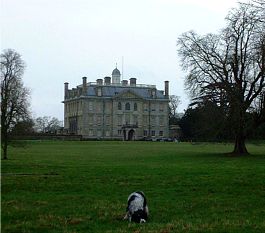 The house
looks very grand on approaching it through the open parkland, with its large
sash windows and observatory on the roof.
The house
looks very grand on approaching it through the open parkland, with its large
sash windows and observatory on the roof.
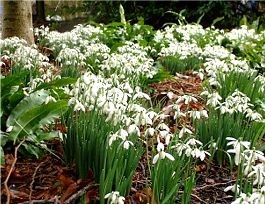 The
house is a very pleasing place to visit in the summer months when the interior
is open to the public (as reviewed last year in the May 2004
Tea Clipper). However, in the depths
of winter after the Christmas break, it also opens the grounds for the seasonal
snowdrop walk. There are masses of these tiny white bell flowers to be enjoyed
on a short walk round the grounds and has become a popular thing to do by those
who want to add a sense of 'Spring is on its way' to their dull winter days. I
thought it would be fun to share this walk with you and hopefully bring a little
spring cheer into your days too.
The
house is a very pleasing place to visit in the summer months when the interior
is open to the public (as reviewed last year in the May 2004
Tea Clipper). However, in the depths
of winter after the Christmas break, it also opens the grounds for the seasonal
snowdrop walk. There are masses of these tiny white bell flowers to be enjoyed
on a short walk round the grounds and has become a popular thing to do by those
who want to add a sense of 'Spring is on its way' to their dull winter days. I
thought it would be fun to share this walk with you and hopefully bring a little
spring cheer into your days too.
Having visited the house in the summer and enjoyed the many treasures within, including the eating room whose walls are hung with Spanish leather and the delightful charms of the beautiful drawing room, with its open, light and rather Edwardian feel about it. It is time to take a walk round the outside and its grounds to appreciate the many delightful vistas.
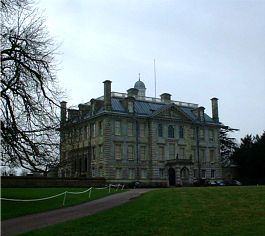 The
north front of the house is the first aspect of the house to be viewed on the
approach. The house was originally built of red brick with Portland stone quoins
(corner stone decorations). However as part of Sir Charles Barry's remodelling
in 1835-40, the then owner William Banks had the house encased entirely in
Chilmark stone. It is this stone-encased house that we see and enjoy today. A
new entrance was formed at this time on the north front, as previously the
entrance was to the east.
The
north front of the house is the first aspect of the house to be viewed on the
approach. The house was originally built of red brick with Portland stone quoins
(corner stone decorations). However as part of Sir Charles Barry's remodelling
in 1835-40, the then owner William Banks had the house encased entirely in
Chilmark stone. It is this stone-encased house that we see and enjoy today. A
new entrance was formed at this time on the north front, as previously the
entrance was to the east.
William Banks was a great collector and filled the house with many treasures, collected from his time spent in Spain, Italy and Egypt. There is a fine collection of Egyptian artefacts in the house as well as an Egyptian obelisk and sarcophagus in the grounds.
Walking round the parkland to the north and east of the house there are some delightful views of this stunning house. The East front has large arched windows where once there was the main entrance to the house, these windows housing a very grand marble main staircase to the house which led visitors up to the principle rooms on the piano noble. Large cedar trees now frame this aspect of the house.
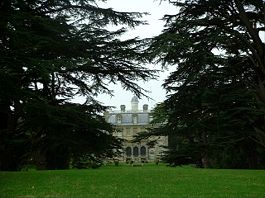
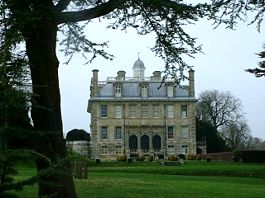
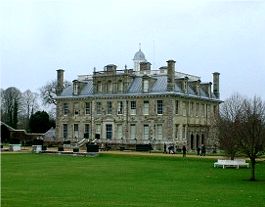 The snowdrop walk leads the visitor
along a predetermined trail around the
grounds on the south-eastern side of the grounds. As I walked away from the house I
could gaze back to appreciate a view of the south front of the house. It is
exquisite, its huge windows which would have allowed light to flood into the
principle rooms, even on a dull winter's day, it must have been a pleasant house
in which to be housed.
The snowdrop walk leads the visitor
along a predetermined trail around the
grounds on the south-eastern side of the grounds. As I walked away from the house I
could gaze back to appreciate a view of the south front of the house. It is
exquisite, its huge windows which would have allowed light to flood into the
principle rooms, even on a dull winter's day, it must have been a pleasant house
in which to be housed.
The first part of the snowdrop walk led into the Victorian fernery. This is a dell-like area, especially constructed with large rocks and sunken paths where ferns could be grown in the heavy shade of the large trees planted within the dell. The Victorians had a great fascination for ferns in the mid-19th century, indeed 'fern mania' became an obsession with intrepid Victorians 'stealing' ferns from the countryside! Special fern trowels were made to dig them up, these were long and narrow to allow the roots to be lifted unharmed. In the summer months when days are hot and sunny, this fern garden produces a tranquil place to sit or wander round in the shade. A small pond and fountain create the sound of running water adding to this cool illusion. In February though, it is not the ferns that we are here to enjoy but the rather humble snowdrops.
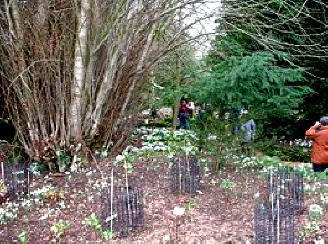
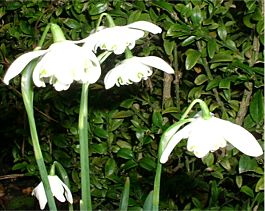
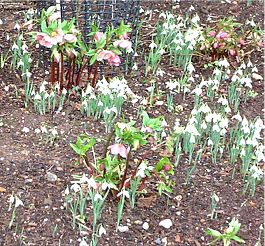
Snowdrops (Galanthus) are a cheery little flower, no taller than about 6" (155mm), there are actually many different varieties, each with their own subtle difference. However, to most people a snowdrop is a snowdrop and are quite happy to not pick out the individualities that abound, but are content to view them as a carpet of white flowers, their petals edged in pale green.
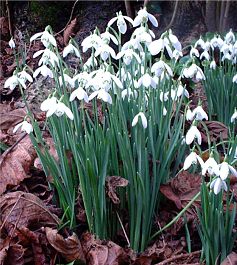
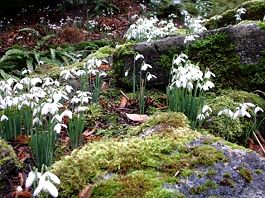
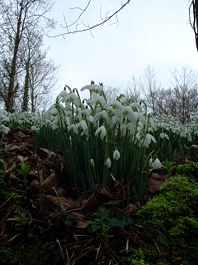
In the dell garden it is particularly useful to be walking in the sunken paths so that you can be level or even have to look up to the snowdrops to be able to appreciate their delicate flowers in their full splendour. Also, set against the rocks covered with bright green moss and the decaying brown leaves from last season's trees makes a lovely setting.
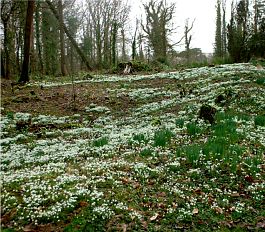
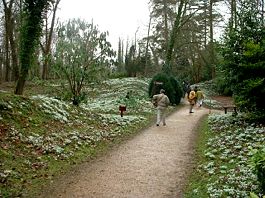
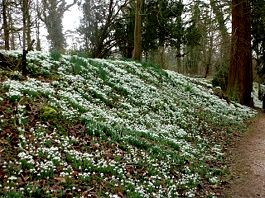
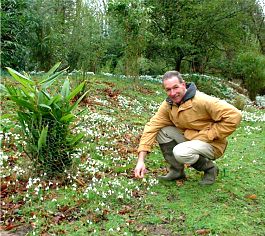 Now
venturing further away from the house the snowdrop trail leads us into the
wooded area of the garden. Naturalistic woods with a winding path has banks on
either side which are white with abundant snowdrops. This white carpet
stretches off into the trees, too numerous to contemplate just how many bulbs
there must be.
Now
venturing further away from the house the snowdrop trail leads us into the
wooded area of the garden. Naturalistic woods with a winding path has banks on
either side which are white with abundant snowdrops. This white carpet
stretches off into the trees, too numerous to contemplate just how many bulbs
there must be.
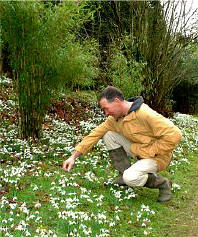 It is worth stopping from time to time to have a closer look at
these pretty flowers at close reach and enjoy their pure white bells flowers
hanging down as if to disguise the beauty within their bloom.
It is worth stopping from time to time to have a closer look at
these pretty flowers at close reach and enjoy their pure white bells flowers
hanging down as if to disguise the beauty within their bloom.
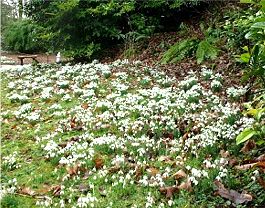 It
was interesting to see that in an area of the wood, there was a notice stating
that there was to be some restoration here of what was created as a 'Japanese
tea garden'. It is now but a circular dell area which has bamboo growing about,
obviously a remnant of the original Japanese style planting. I shall be
interested to watch this progress, I could quite imagine the Victorian ladies
strolling down to this part of the shady wood in summer to sit and take tea
served to them in an elegant fashion within the Japanese garden. What a treat
this must have been, a table set out for their arrival with starched white
linen, best silver tea service and fine Victorian porcelain, with sandwiches and
cakes upon stands.
It
was interesting to see that in an area of the wood, there was a notice stating
that there was to be some restoration here of what was created as a 'Japanese
tea garden'. It is now but a circular dell area which has bamboo growing about,
obviously a remnant of the original Japanese style planting. I shall be
interested to watch this progress, I could quite imagine the Victorian ladies
strolling down to this part of the shady wood in summer to sit and take tea
served to them in an elegant fashion within the Japanese garden. What a treat
this must have been, a table set out for their arrival with starched white
linen, best silver tea service and fine Victorian porcelain, with sandwiches and
cakes upon stands.
Moving on round the trail, we retraced our steps back round the Lime Tree walk. This is a straight avenue of very mature Lime trees with more snowdrops growing round the bases of their huge tree trunks. It is a long vista, the trees and snowdrops looking quite spectacular.
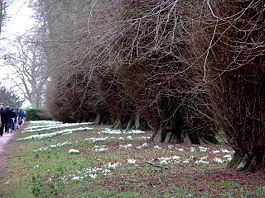
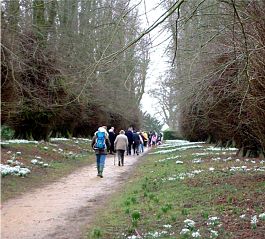
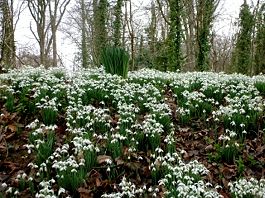
Walking round it is also possible to spot the other occasional early blooming flower and shrub. I spotted some bright yellow Aconites beneath some shrubs adding a brilliant yellow glow to a dull winter's day. Other things that may be spotted if you are lucky is an odd early flowering pink camellia.
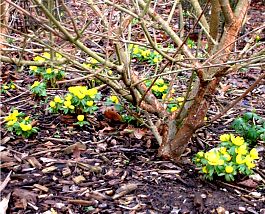
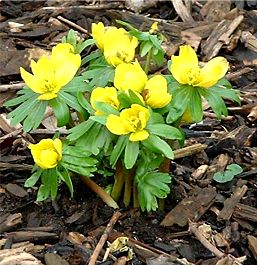
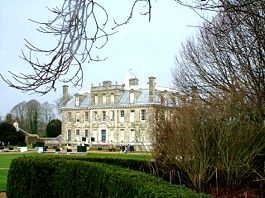
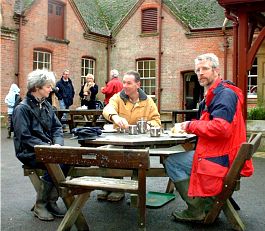
 The
Lime walk leads us back to the south front of the house, beyond which is the
stable block built in 1880, which is now the National Trust's restaurant
and tearoom area. With the weather unseasonably mild I was able to round off the
trip by taking tea sat outside, what a treat to end a delightful afternoon. With
the number of people out to enjoy the snowdrop walk, the restaurant and tearooms
were extremely busy, but I confess it was more than worth the wait to sit and
enjoy a warm fruit scone, obviously fresh from the oven, with a small pot of
strawberry jam and a hot pot of tea.
The
Lime walk leads us back to the south front of the house, beyond which is the
stable block built in 1880, which is now the National Trust's restaurant
and tearoom area. With the weather unseasonably mild I was able to round off the
trip by taking tea sat outside, what a treat to end a delightful afternoon. With
the number of people out to enjoy the snowdrop walk, the restaurant and tearooms
were extremely busy, but I confess it was more than worth the wait to sit and
enjoy a warm fruit scone, obviously fresh from the oven, with a small pot of
strawberry jam and a hot pot of tea.
I hope that my account of this snowdrop walk has brightened your winter's day. Also, if you are fortunate enough to be in this area I can recommend a visit to view the snowdrop walk which is usually open to visitors for most weekends in February. I recommend a phone call to the Trust first - just to make sure it is going to be open when you plan to visit.
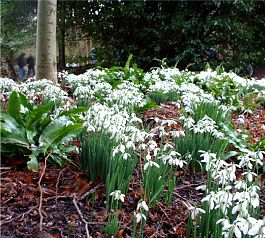
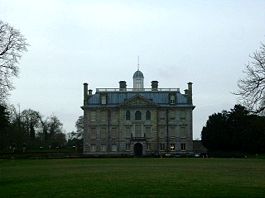
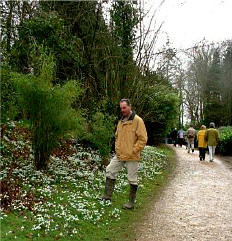
Kingston Lacy
Wimborne Minster
Dorset
BH21 4EA
Tel: 01202 883402
Fax: 01202 882402
Click here for
Local Map
Map courtesy of www.streetmap.co.uk
To review past newsletters, just follow this link:
Past newsletters.
To subscribe to this free newsletter -
Click here